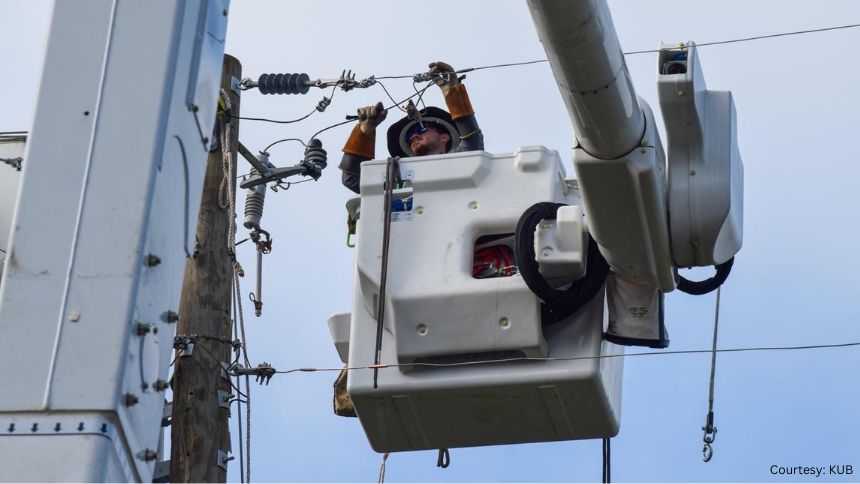
Smart grids, technology, and trucks | What it takes for KUB to restore power after storms
60,000 KUB customers were without power after severe storms in East Tennessee Monday. Let's explore what it took to get them all back online.
Monday’s severe weather in Knoxville left hundreds of people displaced from a tornado, countless trees down, and 60,000 Knoxville Utilities Board (KUB) customers without power.
As that power came back on, it returned in an order not many customers could figure out. How did a neighbor have power back before them? Why were some outages longer than others? And how does KUB know what needs to be fixed and where?
It’s all thanks to a slew of technology the KUB team leans on when severe weather comes our way.
And it starts fairly simply, with watching the radar. “We get updates from the National Weather Service days in advance,” said Gerald Witt, KUB’s Public Information Officer. “As early as Friday, we knew that there was going to be some kind of system, we just didn’t know the severity.”
“That’s when we start planning,” said Andrew Hmielewski, Director of Fiber Operations. KUB starts to gather and schedule crews for post-storm maintenance, prepare emergency communications, and then wait to see what happens.
But that doesn’t mean everyone is waiting idly by for the storm to pass. KUB maintains as much upfront mitigation as possible.
“Trees are definitely the number one cause of outages in high wind events,” Hmielewski said. “And that’s why we spend a lot of time and effort doing things like vegetation management on the front end. But when you have severe wind knocking trees over at that rate, they’re hitting lines, they’re breaking poles, they’re causing damages that take longer than normal to fix.”
Then teams both in KUB offices and out in the field look to assess the damage and find the root cause of the outages. Monday’s storm resulted in 600 “cases of trouble that we had to go diagnose,” said Hmielewski. And those 600 cases caused power outages to 60,000 customers.
“We have an outage management system or OMS, and that collects all of the information from our control systems,” he said. “So we have systems across the service territory that tell us anything about our electric system. That includes if a breaker is out, different protective devices across the distribution system are out. We have automated metering across our infrastructure that tells us the status of the electric meters, so it reports if they have power or not.”
Hmielewski said since trees caused so many of the most recent outages, response time was a little slower, as crews often had to clear branches before work could begin. He said what would only take an hour or so to fix on a sunny day could take up to 16 hours in a severe weather situation. Witt said 170 crews from KUB, as well as neighboring states and contractors, all came in to restore power.
When it comes to prioritizing who gets power back first, it’s a combination of the severity of the outage and the necessity of that customer to have power. For example, Witt said power restoration is prioritized at hospitals and schools, then areas where large amounts of customers are out, and then they work down the list from there. Larger distribution lines serving smaller lines in neighborhoods often must be repaired first.
“That’s all strategic, it’s all intentional. It’s not a willy-nilly sort of thing,” said Witt. “We are ready to respond all the way down to the individual customer as the case may need.”
Witt and the communications team take customer messages, communicate on social media, and try to post constant updates so customers know what’s going on. All the meters and other district-wide technology Hmielewski references populate KUB’s online outage map, which gives customers estimated restoration times.
“All of these communications are an attempt to give people the information as we have it, as best as we can provide it, but then also to provide peace of mind,” said Witt. “Yes, we’re here. We hear you. We’re responding. We’re working on it. And this is what we’re doing.”
As technology advances, so does KUB’s electrical grid. Hmielewski said KUB is in the process of installing 5,000 miles of fiber cable over the next seven years. That not only gives customers the option for fiber internet (Lonsdale, Mechanicsville, and the area around Knoxville College, you’re up next) but allows the KUB electrical grid to get smarter through the use of artificial intelligence.
Here’s how that works. Your power comes from a feeder, where up to 3,000 other customers are also getting their power. If something happens to it, you’re all out of power. But if everyone is segmented out and connected to multiple feeders, then a failure in one would be detected by another a fixed automatically.
Meaning instead of losing power, maybe it flickers, or maybe you don’t notice at all.
“These intelligent grids are all doing automation to try to minimize the impact on their own,” said Hmielewski. “So our grid is being modified with artificial intelligence to minimize the number of customers impacted.”
He said KUB is in the early stages of implementing this technology, but as more fiber is laid, the grid will get smarter, and hopefully, more outages will be fixed before anyone notices they’re broken.
“That’s really going to be the beginning of what we see as a big change in improving reliability,” said Hmielewski. “It’s not going to change the number of trees that fall, it’s not going to cause fewer poles to be broken. But what it will do is minimize the number of customers affected by every one of those trees that fall, so we’re really excited about what the future holds in that space.”
Like what you've read?
Forward to a friend!

